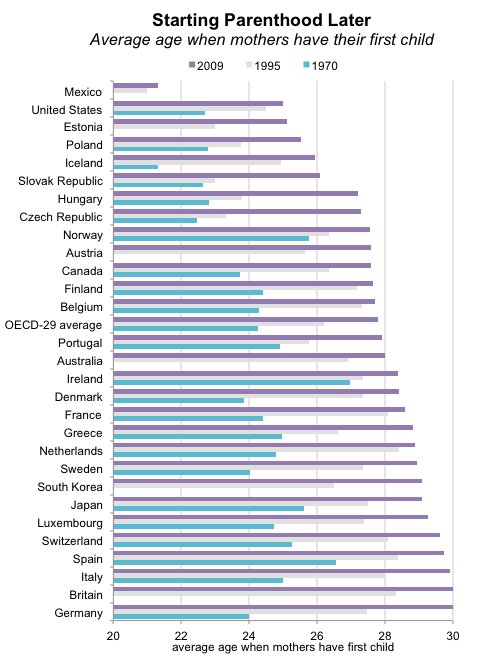
CATHERINE RAMPELL
Dollars to doughnuts.
While digging through the Organization for Economic Cooperation and Development’s annual education report last week, I came across this fascinating chart:
 Source: Organization for Economic Cooperation and Development.
Source: Organization for Economic Cooperation and Development.
It shows that across the developed world, women have been waiting longer to have their first child. The average age of first childbirth was 24.3 in 1970 compared to 27.8 in 2009, the most recent year for which comparable international data are available. That’s not a huge surprise; as more women have entered the labor force, many have delayed child-rearing.
More striking, at least to me, is how young new mothers are in the United States versus the rest of the developed world. In the United States in 2009, the average age for a mother who just had her first child was 25; only Mexico had a lower age at first childbirth, 21.3.
On the other end of the spectrum are Germany and Britain, where average age at first childbirth was 30.
For more data on fertility around the world, the O.E.C.D. offers this compilation of statistics.
You can also find data on age at first childbirth by American state from the Centers for Disease Control and Prevention, though the most recent state-level data I’ve been able to find are from 2006. That year, new mothers in Mississippi were the youngest, averaging 22.6 years old at first childbirth, and those in Massachusetts were the oldest, averaging 27.7 years old.
Finally, for a look at the extraordinarily high (and growing) costs of childbirth in the United States, see this article by my colleague Elisabeth Rosenthal.
Article source: http://economix.blogs.nytimes.com/2013/07/01/americas-new-mothers-among-the-youngest/?partner=rss&emc=rss
